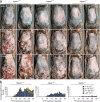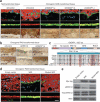IQGAP1 scaffold-kinase interaction blockade selectively targets RAS-MAP kinase-driven tumors
- PMID: 23603816
- PMCID: PMC4190012
- DOI: 10.1038/nm.3165
IQGAP1 scaffold-kinase interaction blockade selectively targets RAS-MAP kinase-driven tumors
Abstract
Upregulation of the ERK1 and ERK2 (ERK1/2) MAP kinase (MAPK) cascade occurs in >30% of cancers, often through mutational activation of receptor tyrosine kinases or other upstream genes, including KRAS and BRAF. Efforts to target endogenous MAPKs are challenged by the fact that these kinases are required for viability in mammals. Additionally, the effectiveness of new inhibitors of mutant BRAF has been diminished by acquired tumor resistance through selection for BRAF-independent mechanisms of ERK1/2 induction. Furthermore, recently identified ERK1/2-inducing mutations in MEK1 and MEK2 (MEK1/2) MAPK genes in melanoma confer resistance to emerging therapeutic MEK inhibitors, underscoring the challenges facing direct kinase inhibition in cancer. MAPK scaffolds, such as IQ motif-containing GTPase activating protein 1 (IQGAP1), assemble pathway kinases to affect signal transmission, and disrupting scaffold function therefore offers an orthogonal approach to MAPK cascade inhibition. Consistent with this, we found a requirement for IQGAP1 in RAS-driven tumorigenesis in mouse and human tissue. In addition, the ERK1/2-binding IQGAP1 WW domain peptide disrupted IQGAP1-ERK1/2 interactions, inhibited RAS- and RAF-driven tumorigenesis, bypassed acquired resistance to the BRAF inhibitor vemurafenib (PLX-4032) and acted as a systemically deliverable therapeutic to significantly increase the lifespan of tumor-bearing mice. Scaffold-kinase interaction blockade acts by a mechanism distinct from direct kinase inhibition and may be a strategy to target overactive oncogenic kinase cascades in cancer.
Figures




Comment in
-
Targeting RAF-MEK-ERK kinase-scaffold interactions in cancer.Nat Med. 2013 May;19(5):538-40. doi: 10.1038/nm.3195. Nat Med. 2013. PMID: 23652103 No abstract available.
-
Mind the IQGAP.Cancer Cell. 2013 Jun 10;23(6):715-7. doi: 10.1016/j.ccr.2013.05.017. Cancer Cell. 2013. PMID: 23763998
References
-
- Downward J. Targeting RAS signalling pathways in cancer therapy. Nat. Rev. Cancer. 2003;3:11–22. - PubMed
-
- McCormick F. Cancer therapy based on oncogene addiction. J. Surg. Oncol. 2011;103:464–467. - PubMed
-
- Scholl FA, et al. MEK1/2 MAPK kinases are essential for mammalian development, homeostasis, and Raf-induced hyperplasia. Dev. Cell. 2007;12:615–629. - PubMed
Publication types
MeSH terms
Substances
Grants and funding
LinkOut - more resources
Full Text Sources
Other Literature Sources
Molecular Biology Databases
Research Materials
Miscellaneous

